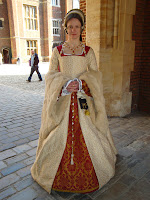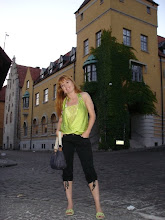Located in Surrey, the Hampton Court Palace is a beautifully situated palace and gardens by the Thames and we were lucky with the weather. The sun was shining and it was a lovely spring day. Frank took a nap on the lawn of the Great Fountain Garden while I took a walk through the palace.


The palace has an interesting history. The estate at Hampton Court once belonged to a religious order founded in the 11th century. They used the area as an agricultural estate and hosted a few administrative buildings and a high-status guesthouse visited by royal guests on occasion. In 1514, the Archbishop of York, Thomas Wolsey, took out a 99-year lease on the property and built a grand bishop’s palace there. Wolsey became Cardinal and Lord Chancellor of England and he was also a close friend of Henry VIII and served as his chief minister for over ten years. In addition to his own private chambers (called the Wolsey Rooms in today’s palace leaflets), Wolsey added three guest suites for the royal family – one for King Henry VIII, one for Queen Katherine of Aragon and their daughter Princess Mary – and built a chapel.
 Henry VIII (1509-47) was only 17 when he became King of England, Ireland and France and the Hampton Court Palace is this year celebrating the 500th
Henry VIII (1509-47) was only 17 when he became King of England, Ireland and France and the Hampton Court Palace is this year celebrating the 500th anniversary of the Tudor king’s accession to the throne with a lot of historical activities, lectures, performances and costumed interpretations. When we were there actors were staging the day of the wedding of King Henry to his sixth wife, Kateryn (Catherine) Parr, in full velvet and embroidered costumes of the period.
anniversary of the Tudor king’s accession to the throne with a lot of historical activities, lectures, performances and costumed interpretations. When we were there actors were staging the day of the wedding of King Henry to his sixth wife, Kateryn (Catherine) Parr, in full velvet and embroidered costumes of the period.


Visitors were told how to bow and curtsey in the presence of royal, learned what it was like to work at the court and be a servant, what the clothes fashion was like in the Tudor era etc. It was very interesting.
I visited King Henry’s State Apartments, including the Great Hall with large, impressive tapestries hanging from the walls, and the Chapel Royal which has been in use for over 450 years. It was in this chapel that Henry’s son, Edward VI, was baptized and also where the marriage between Henry VIII and Kateryn Parr took place. The chapel is still in use today.

 Henry VIII (1509-47) was only 17 when he became King of England, Ireland and France and the Hampton Court Palace is this year celebrating the 500th
Henry VIII (1509-47) was only 17 when he became King of England, Ireland and France and the Hampton Court Palace is this year celebrating the 500th anniversary of the Tudor king’s accession to the throne with a lot of historical activities, lectures, performances and costumed interpretations. When we were there actors were staging the day of the wedding of King Henry to his sixth wife, Kateryn (Catherine) Parr, in full velvet and embroidered costumes of the period.
anniversary of the Tudor king’s accession to the throne with a lot of historical activities, lectures, performances and costumed interpretations. When we were there actors were staging the day of the wedding of King Henry to his sixth wife, Kateryn (Catherine) Parr, in full velvet and embroidered costumes of the period.

Visitors were told how to bow and curtsey in the presence of royal, learned what it was like to work at the court and be a servant, what the clothes fashion was like in the Tudor era etc. It was very interesting.
I visited King Henry’s State Apartments, including the Great Hall with large, impressive tapestries hanging from the walls, and the Chapel Royal which has been in use for over 450 years. It was in this chapel that Henry’s son, Edward VI, was baptized and also where the marriage between Henry VIII and Kateryn Parr took place. The chapel is still in use today.

The Great Hall
I joined a group of people into a room and listened to a questions & answers session around what people at the court were wearing and what materials were used. Apparently one of the fancy velvet and silk gowns with golden-embroidered bodices that a lady at the court would wear would have cost around £10,000 in today’s money and a wealthy lady would own maybe five of those in different colors. Of course these garments couldn’t be washed, only the white cotton or linen under-tunic could. The height of masculinity in the Tudor era was muscular calves – if you were not so well-equipped in this department, you might even have worn padded stockings to hide this deficit. Male fashion namely prescribed tights and padded breeches (instead of today’s trousers) and knee-long mantles to appropriately display your calves.


I joined a group of people into a room and listened to a questions & answers session around what people at the court were wearing and what materials were used. Apparently one of the fancy velvet and silk gowns with golden-embroidered bodices that a lady at the court would wear would have cost around £10,000 in today’s money and a wealthy lady would own maybe five of those in different colors. Of course these garments couldn’t be washed, only the white cotton or linen under-tunic could. The height of masculinity in the Tudor era was muscular calves – if you were not so well-equipped in this department, you might even have worn padded stockings to hide this deficit. Male fashion namely prescribed tights and padded breeches (instead of today’s trousers) and knee-long mantles to appropriately display your calves.


King Henry had six wives. It was only his first wife, Katherine of Aragon, whom he married in 1509, that lasted over 20 years, the rest followed each other in fairly quick succession: Anne Boleyn in 1532/1533, Jane Seymour in 1536, Anne of Cleves and Catherine Howard both in the same year (1540) and finally Kateryn Parr in 1543. Henry was a passionate man and a womanizer, but his youthful charm and wits over the years turned into ruthlessness and he had a rather brutal way of dismissing his wives when he got tired of them. The first one he divorced, or rather he had the marriage annulled since Katherine of Aragon failed to produce a male heir and he became obsessed to possess the younger Anne Boleyn with whom he had fallen in love. It was in this period that Hampton Court Palace was appropriated by Henry VIII from Cardinal Wolsey as a result of the king breaking with the Catholic Church, since the Pope refused to grant him the divorce he so desperately wanted.
Queen Anne was beheaded just a few years after the marriage supposedly for ‘high treason’. Jane unfortunately died of postnatal complications after having given birth to Henry’s first male heir (Edward VI). The fourth marriage with Anne of Cleves was never consummated and it was subsequently annulled later that year. The young Catherine, Henry’s fifth wife, had an affair and was executed as a result, as were her lover and an ex-lover. The sixth wife, Kateryn, known as Lady Latimer before she became Henry VIII’s final wife, nursed him by the end when he was crippled and sick, and she was probably glad just to survive him.
When Henry died in 1547 he had three surviving children – the 9-year old Prince Edward and his older sisters Mary and Elizabeth. They have all ruled England and Hampton Court continued to be an important royal palace during the Tudor era. Only half of King Henry’s palace has survived since the 16th century, the rest was rebuilt for William III (William of Orange) and Mary II as a baroque palace during the 18th century.
I also saw Mary II’s Apartments, the palace’s wine cellar and the Tudor kitchens. The latter displayed various cooking utensils, fake log-fires in wood-fire ovens, vegetables, herbs, bread, stuffed rabbits and other food that you would have seen in a medieval kitchen when preparing meals for some 800 people in Henry VIII’s court.

Queen Anne was beheaded just a few years after the marriage supposedly for ‘high treason’. Jane unfortunately died of postnatal complications after having given birth to Henry’s first male heir (Edward VI). The fourth marriage with Anne of Cleves was never consummated and it was subsequently annulled later that year. The young Catherine, Henry’s fifth wife, had an affair and was executed as a result, as were her lover and an ex-lover. The sixth wife, Kateryn, known as Lady Latimer before she became Henry VIII’s final wife, nursed him by the end when he was crippled and sick, and she was probably glad just to survive him.
When Henry died in 1547 he had three surviving children – the 9-year old Prince Edward and his older sisters Mary and Elizabeth. They have all ruled England and Hampton Court continued to be an important royal palace during the Tudor era. Only half of King Henry’s palace has survived since the 16th century, the rest was rebuilt for William III (William of Orange) and Mary II as a baroque palace during the 18th century.
I also saw Mary II’s Apartments, the palace’s wine cellar and the Tudor kitchens. The latter displayed various cooking utensils, fake log-fires in wood-fire ovens, vegetables, herbs, bread, stuffed rabbits and other food that you would have seen in a medieval kitchen when preparing meals for some 800 people in Henry VIII’s court.

Mary II’s Apartments
The Tudor Kitchens
We took a walk in the beautiful and enormous palace gardens, which are divided into several ones with different character. We didn’t have time to walk through all, but started in the Great Fountain Garden, originally parkland. The yew trees you see on the photo below were planted by Queen Anne (1702-14).
We took a walk in the beautiful and enormous palace gardens, which are divided into several ones with different character. We didn’t have time to walk through all, but started in the Great Fountain Garden, originally parkland. The yew trees you see on the photo below were planted by Queen Anne (1702-14).
The Great Fountain Garden
We also saw the Privy Garden, the king’s private garden completed for William III in the early 1700’s, and the smaller Knot Garden.

The Privy Garden
The Pond Gardens were originally ponds with freshwater fish for the palace but are now sunken, pretty flower gardens located between the palace and the river. Next to them is the Banqueting House which will have to be the target for another visit.

The Pond Gardens and the Banqueting House

Lower Orangery Garden
We walked down the Orangery Garden to the Great Vine – apparently the oldest and largest grape vine in the world with its respectable 240 years, planted in 1768 – located in a green house close to the river but it was unfortunately not displaying any grapes this time of year.
We ended our visit with tea and scones at the Tiltyard Café. During Henry VIII’s reign this area was used for tournaments. In the 17th century it became kitchen gardens, supplying the palace with fresh produce.
Hampton Court Palace is well worth a visit and you can even take a boat ride here from either Westminster Pier in central London or from Richmond. That will probably be our chosen transportation on our next visit.






